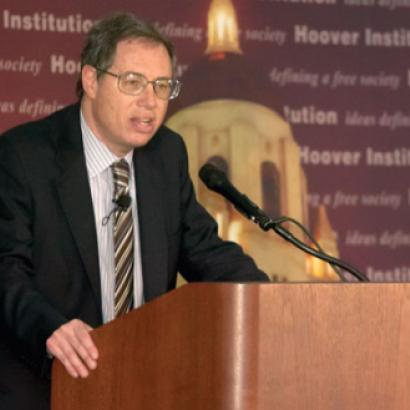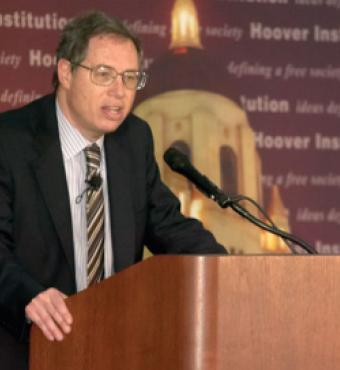- Budget & Spending
- Economics
- Law & Policy
- Regulation & Property Rights
- Contemporary
- Politics, Institutions, and Public Opinion
- History
There is no getting around the fact that any discussion of the bailout chronicles American failures, not American successes. Our short-term breakdown is often expressed as one that pits Wall Street against Main Street. That is not quite right. The deeper issues are how do we identify the causes of the meltdown, and where do we go from here?
To approach this problem, it is useful to make an analogy between our financial distress and the diseases of the human body. The first step is diagnosing the disease. Only then is it possible to choose from among treatments. Diagnosing the disease is difficult, but often easier than choosing the best treatment. Recall that sometimes a sound diagnosis produces evidence of an incurable disease, a dire condition I don’t think describes our bailout problem. The body politic will recover at some point, but the road to recovery may be longer and more arduous than need be.
Much has been written about what went wrong—the diagnosis—with its untoward combination of easy credit, government subsidies, opaque securitization packages, and mark-to-market accounting. So here I’d like to focus on the treatment. How can we begin the healing process? How can we get this country moving again?
These are not easy questions to answer. Even smart economists are notoriously reluctant to come forward with confident solutions to this mess, in part because they don’t want to get burned by looking foolish tomorrow after being overconfident today. But in part it is a question of comparative advantage: economists are good at discussing macrotrends, but they’re usually less skilled in applying economic principles to complicated legal arrangements whose details they do not fully grasp. Unfortunately, it’s difficult for a learned economist to deal with restructuring a failed entity without some notion of the problems posed by various kinds of mortgage paper.
One principle we have learned is to keep our eye on the ball. The first time the bailout went to the House of Representatives, it failed—because it was simply too short, focused, and sensible, and therefore doomed! Resolutely, Congress found a way to turn a four-page statute into a five-hundred- page Christmas tree. Every silly or dubious social problem that could not pass on its own became an ornament to the bailout program. The initial defeat of the simple bill opened up opportunities to sell everyone’s vote to stop financial distress for some unrelated goody. In attempting to cleanse our financial house, we spread the financial malaise throughout the system. The professionals ceded control of the process to a Congress that marched to a different drummer. I don’t claim that financial professionals will always be right, but on average the Treasury Department and the Federal Reserve will be subject to fewer temptations and make fewer mistakes than Congress. Put another way, the professionals add and subtract numbers. Congress just adds programs that spend other people’s money.
So, then, how does one figure out how to run a bailout? I believe we should break the problem into two parts: the steps we should try to do and the steps that we should assiduously avoid.
THE UPSIDE
What can we do constructively?
First, we can have government buy some of this troubled paper and take it off companies’ books to restore their solvency. But some could say in response, “Wait a second: if it’s terrible paper, why would you want to have the government saddled with this junk, instead of leaving it with the firm that made the original loan? This buyout is just a sop to the incompetence of our bankers.” But a fierce logic behind this suggests that a government takeover could well be a value-improving transaction. The argument goes something like this: if the government takes over this paper from private holders, they will have a permanent holiday from “mark-to-market” accounting, an esoteric notion that requires the firm to write down assets from costs to current value, whether or not they are sold. In practice, it led to a cascade whereby ever greater quantities of paper were dumped onto the market at once at distress prices. Free of that requirement, the government can hold this paper for an indefinite amount of time. It can then value it by discounting the future cash value, not current sale prices. The future cash value reflects the present value of the future payments, which is systematically greater than the mark-to-market calculations. So assume mark-to-market values paper at 20 cents on the dollar when its discounted cash flows are worth 50 cents on the dollar. If the government pays its holders 35 cents on the dollar, everybody comes out a winner in the long run. The banks get enough money from these transactions to put their capitalization requirements in order, and the government pays a small enough amount for the paper to allow its orderly resale at a profit down the road. The government purchase insulates the paper from short-term downward pressures. This is not a perfect solution, but bailouts operate in the world of second-best. So we settle for an improvement and spurn the fruitless quest for perfection.

The second approach is to change banks’ behavior by injecting cash into them to lift them over the minimum levels they need to stay in business. Once again, there is no free lunch. It is always dangerous to print money because it is a sure way to fuel inflationary tendencies. Yet the economy shriveled up by several trillion dollars when the stock market went south, so the infusion of cash may in fact help rebalance the books to avoid a potential deflation that could prove every bit as dangerous as it was in the 1930s, when prolonged inflation required people to discharge their longterm debts in dollars that were much more valuable than the ones they had borrowed. The systematic failure led to a breakdown of the banking system. The prudent monetarist wants to keep banks alive. Alas, the cash infusion may well be the lesser of evils.
There are, of course, risks in both scenarios. In the first, when the government acquires troubled paper, what is it supposed to do with it? Put it in Fort Knox and let it rot? Manage it? Try to resell it in the market? Only the second and third options work, and it is easy to go astray on both. Because we don’t want the government to hold the paper forever, it becomes necessary to divide it into different tranches. The government has to place different managers in charge of each, with the expectation of selling it back into the private market at decent prices at some point (when timing is everything). So the Treasury role that begins with the takeover requires careful execution in the midst of political forces that could easily derail its efforts. We face scary prospects if Congress seizes yet another opportunity for creative accounting and meddlesome intervention.
Parallel problems infect the injection of capital. When the government advances capital to these distressed firms, it must take something back in return; no simple giveaway is proper. But how much capital should it invest, and what kind of stake should it take in return? We need rapidly drawn-up treaties to figure out exactly how much shareholder control the government should exert on governance matters. Can it veto certain transactions? Control executive salaries? Appoint members of the board of directors? Down the road, what’s the exit strategy? For long-term stability, we do not want the government owning partial interest in the banks because the European version of state-owned industries reminds us that every time the government functions as both owner and regulator, it confuses roles and often gives itself preferences over other firms that have no public stake.
It’s clear that even the best solutions we can identify create the risk of major political mismanagement down the road. Yet nobody is smart enough to solve these problems without running these large risks. It will take political fortitude and institutional solidity to carry out this mission.
DANGERS AND RISKS
Now that we have seen the sensible strategies, let us return to the constant theme of danger.
The first danger is to think that the bailout is the first step to a future transformation of society in favor of greater regulation in all areas of life. But the financial failures do not change the calculations on these programs. Whatever one thinks of global warming, the financial meltdown should not be confused with the melting of the Arctic ice cap. We need to keep our eyes on the distinctive features of banking (and banking runs) that call for regulation. Overgeneralization could prove fatal.
The second danger arises from the much-discussed relationship between Wall Street and Main Street. Can government cure the crisis on the creditor side while trying to offer debtor relief? Ultimately, this comes down to the question of how the government should handle the hot-button issue of foreclosures on Main Street.
Unfortunately, no government can ease both problems simultaneously. Once the state adopts special rules of leniency for property in foreclosure, it increases the risk and uncertainty on the creditor side of the transaction. The state cannot escape this particular dilemma by wishing things were otherwise. In the world of hard choices, how do we choose between these two ends? I believe we must be extremely tough on the foreclosure side. We must follow a path that will be criticized as lacking compassion to home owners to improve the overall situation. It’s essential to understand that by strengthening banks, the government strengthens people on Main Street as well as people on Wall Street.
Furthermore, we must not fall into the trap of thinking that all mortgagees were born equal. The idea that somehow all home owners ought to be secure, regardless of prudence and responsibility, projects the wrong message. Some home owners have acquired extensive equity in their homes by acting prudently throughout. Others have borrowed to the limit and purchased multiple properties, often for speculation. Still others are in between. We need to preserve the incentive structure that rewards those persons who did not take risks. But we only punish their prudence by taxing them severely.
Why this misplaced compassion? In the United States we observe the strong tendency to play what I call the distribution game. What we do is put entities on one side of the line and assume that they do not represent the individuals who invest in them or work in them. We then put “flesh and blood individuals” on the other side of this line, thinking we can increase their wealth without worrying unduly about the erosion of institutional wealth.
This approach is foolish for two reasons. First, it elides the human beings whose livelihood depends on institutional well-being and thereby ignores their place, and their losses, in the social welfare function. Second, that truncation of relevant interests always leads to bad social policy. In a game this complicated, the first order of business is to maximize the size of the pie. No government can achieve that goal by prolonging uncertainty and subsidizing unstable property arrangements at the risk of imposing taxes that could send prudent home owners over the brink. By prolonging foreclosures, the government invites another round of difficulties when further foreclosures become necessary six to nine months from now. It is unwise to keep these complex transactions alive. It is best to close the book on them so as to return the unencumbered property to the real estate marketplace as quickly as possible.
Unfortunately, in the current environment, it is necessary to fight debtor-relief legislation time after time. Indeed, as I look at the political landscape, I see only mindless populists in both parties controlling the rhetoric. All too often they reduce complex financial matters to a single variable: “greed.” Greed is a constant of human life. It is part of good times and bad times. Some individuals are greedy and others less so. Fine, and so what? The question is, how do we put together a set of rules and institutions in which individuals seeking their own advantage also create advantages for other individuals? Adam Smith saw how that relationship worked with competitive markets. Two hundred years of historical experience and mishaps have not proved him wrong.
When we look at the current political situation, Smith’s insights are lost or belittled. Instead, we see the compromise of long-term principle in favor of short-term gimmicks. It all catches up with us in the end. Financial ruin and confusion will be our national lot if we fail to focus on the essentials. We can, and we must, return to principle in this time of crisis. I fear for our collective future if we do not.
















